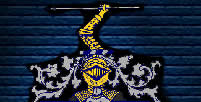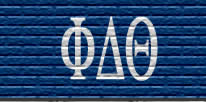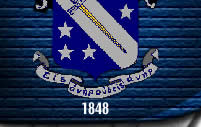




 History
History


Ohio Gamma: A Brief History
In the year 1839, a young man by the name of Robert Morrison enrolled at Ohio University, thus beginning the rich history surrounding the Phi Delta Theta fraternity at OU. Although it wasn't until twenty-nine years later that the original charter for Ohio Gamma was issued, it was a sign of the prosperous times to come over the next 130 years.
That charter came on March 28, 1868, and was granted to three men: Thomas L. Hughes, Edison B. Miesse, and J.W. Shinn, who have now become known as our second founding fathers. Although we are now Ohio Gamma, the original charter was issued to us as Ohio Beta. Ohio Wesleyan was originally Ohio Beta, but with the onset of the Civil War came a drop in numbers, which forced the existing Phi's at Ohio Wesleyan to close, opening the door for Hughes, Miesse, and Shinn to accept their charter. In 1875, the convention went over the list of charters in Ohio, at which time they rearranged some of them and Ohio U. was given Ohio Epsilon. This all happened again at the convention of 1880 when the Phi's at Ohio U. were given their existing name, Ohio Gamma, and Ohio Wesleyan was reissued Ohio Beta.
1869 saw three new members initiated into Phi Delta Theta. William Edwin Williams, Vernon Culver Stiers, and William Alexander Brown became Phi's, sending the chapters numbers past the numbers of Beta Theta Pi and Delta Tau Delta, both of which had been established on the O.U. campus prior to Phi Delta Theta. Within two years the fraternity to 20 members. Within 15 years since the original charter, the fraternity's numbers had grown to 73.
Numerous places around campus have been called home by Phi Delta Theta, including South Court Street, North College, East Union Street, University Terrace, and South Congress. But perhaps the most well known building to be owned by Phi's at O.U. is the infamous "Castle on the Hocking" located on West Mulberry Street. This historic building was the first on campus to be built specifically for a fraternity. The house was completed in September of 1916.
No sooner had the Phi Delts moved in than World War I began, and numbers began to diminish. Military training programs at the university are credited for having kept the chapter alive, as well as a lot of well thought out planning by Phi's of that time. When the war finally ended in 1918, the house at Mulberry Street boasted a list of Phi's that served in the war, all of which could be seen over the fireplace in the main atrium.
The Second World War damaged the Phi Delts at O.U. even more severely than did the first, but again it was the Army training program and more thorough planning by members that kept the chapter intact. When the war let out, however, numbers soared. At some points the chapter was up over 120 men, and in March of 1953 Richard Lee Miller, '56, was initiated as the 1,000th member of the Ohio Gamma chapter of Phi Delta Theta.
Information collected by D. Merrill Wheeler Jr. with help from "Ohio Gamma's First 100 Years," by Charles W. Reamer '33.
__________________________________________________________________
[Home] [Rush] [History] [Brothers] [Pictures]
[Contact Us] [Ohio University] [GHQ]